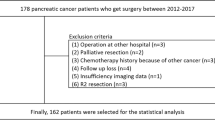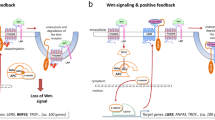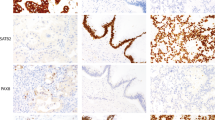Abstract
The identification of molecular markers, useful for therapeutic decisions in pancreatic cancer patients, is crucial for advances in disease management. Gemcitabine, although a cornerstone of current therapy, has limited efficacy. RRM1 is a key molecule for gemcitabine efficacy and is also involved in tumor progression. We determined in situ RRM1 and excision repair cross complementation group 1 (ERCC1) protein levels in 68 pancreatic cancer patients. All had R0 resections without preoperative therapy. Protein levels were determined by automated quantitative analysis (AQUA), a fluorescence-based immunohistochemical method. The relationship between protein expressions and clinical outcomes, including response to gemcitabine at the time of disease recurrence, was determined. Patients with high RRM1 showed significantly better overall survival than patients with low expression (P=0.0196). There was a trend toward better overall survival for patient with high ERCC1 (P=0.0552). When both markers were considered together, patients with both high RRM1 and ERCC1 faired the best in terms of overall and disease-free survival (P=0.0066, P=0.0127). In addition, treatment benefit from gemcitabine in patients with disease recurrence was observed only in patients with low RRM1. The combination of RRM1 and ERCC1 expression is prognostic in pancreatic cancer patients after a complete resection. On disease recurrence, only patients with low RRM1 derive benefit from gemcitabine.
This is a preview of subscription content, access via your institution
Access options
Subscribe to this journal
Receive 50 print issues and online access
$259.00 per year
only $5.18 per issue
Buy this article
- Purchase on Springer Link
- Instant access to full article PDF
Prices may be subject to local taxes which are calculated during checkout




Similar content being viewed by others
References
Bachem MG, Schunemann M, Ramadani M, Siech M, Beger H, Buck A et al. (2005). Pancreatic carcinoma cells induce fibrosis by stimulating proliferation and matrix synthesis of stellate cells. Gastroenterology 128: 907–921.
Bepler G, Kusmartseva I, Sharma S, Gautam A, Cantor A, Sharma A et al. (2006). RRM1 modulated in vitro and in vivo efficacy of gemcitabine and platinum in non-small-cell lung cancer. J Clin Oncol 24: 4731–4737.
Bepler G, Sharma S, Cantor A, Gautam A, Haura E, Simon G et al. (2004). RRM1 and PTEN as prognostic parameters for overall and disease-free survival in patients with non-small-cell lung cancer. J Clin Oncol 22: 1878–1885.
Bergman AM, Eijk PP, Ruiz van Haperen VW, Smid K, Veerman G, Hubeek I et al. (2005). in vivo induction of resistance to gemcitabine results in increased expression of ribonucleotide reductase subunit M1 as the major determinant. Cancer Res 65: 9510–9516.
Boeck S, Heinemann V . (2008). Second-line therapy in gemcitabine-pretreated patients with advanced pancreatic cancer. J Clin Oncol 26: 1178–1179; author reply 1179.
Burris III HA, Moore MJ, Andersen J, Green MR, Rothenberg ML, Modiano MR et al. (1997). Improvements in survival and clinical benefit with gemcitabine as first-line therapy for patients with advanced pancreas cancer: a randomized trial. J Clin Oncol 15: 2403–2413.
Camp RL, Chung GG, Rimm DL . (2002). Automated subcellular localization and quantification of protein expression in tissue microarrays. Nat Med 8: 1323–1327.
Cao MY, Lee Y, Feng NP, Xiong K, Jin H, Wang M et al. (2003). Adenovirus-mediated ribonucleotide reductase R1 gene therapy of human colon adenocarcinoma. Clin Cancer Res 9: 4553–4561.
Cascinu S, Berardi R, Labianca R, Siena S, Falcone A, Aitini E et al. (2008). Cetuximab plus gemcitabine and cisplatin compared with gemcitabine and cisplatin alone in patients with advanced pancreatic cancer: a randomised, multicentre, phase II trial. Lancet Oncol 9: 39–44.
Ceppi P, Volante M, Novello S, Rapa I, Danenberg KD, Danenberg PV et al. (2006). ERCC1 and RRM1 gene expressions but not EGFR are predictive of shorter survival in advanced non-small-cell lung cancer treated with cisplatin and gemcitabine. Ann Oncol 17: 1818–1825.
Davidson JD, Ma L, Flagella M, Geeganage S, Gelbert LM, Slapak CA . (2004). An increase in the expression of ribonucleotide reductase large subunit 1 is associated with gemcitabine resistance in non-small cell lung cancer cell lines. Cancer Res 64: 3761–3766.
Dumontet C, Fabianowska-Majewska K, Mantincic D, Callet Bauchu E, Tigaud I, Gandhi V et al. (1999). Common resistance mechanisms to deoxynucleoside analogues in variants of the human erythroleukaemic line K562. Br J Haematol 106: 78–85.
Fan H, Huang A, Villegas C, Wright JA . (1997). The R1 component of mammalian ribonucleotide reductase has malignancy-suppressing activity as demonstrated by gene transfer experiments. Proc Natl Acad Sci USA 94: 13181–13186.
Gautam A, Bepler G . (2006). Suppression of lung tumor formation by the regulatory subunit of ribonucleotide reductase. Cancer Res 66: 6497–6502.
Gautam A, Li ZR, Bepler G . (2003). RRM1-induced metastasis suppression through PTEN-regulated pathways. Oncogene 22: 2135–2142.
Giovannetti E, Del Tacca M, Mey V, Funel N, Nannizzi S, Ricci S et al. (2006). Transcription analysis of human equilibrative nucleoside transporter-1 predicts survival in pancreas cancer patients treated with gemcitabine. Cancer Res 66: 3928–3935.
Goan YG, Zhou B, Hu E, Mi S, Yen Y . (1999). Overexpression of ribonucleotide reductase as a mechanism of resistance to 2,2-difluorodeoxycytidine in the human KB cancer cell line. Cancer Res 59: 4204–4207.
Heinemann V, Quietzsch D, Gieseler F, Gonnermann M, Schonekas H, Rost A et al. (2006). Randomized phase III trial of gemcitabine plus cisplatin compared with gemcitabine alone in advanced pancreatic cancer. J Clin Oncol 24: 3946–3952.
Herrmann R, Bodoky G, Ruhstaller T, Glimelius B, Bajetta E, Schuller J et al. (2007). Gemcitabine plus capecitabine compared with gemcitabine alone in advanced pancreatic cancer: a randomized, multicenter, phase III trial of the Swiss Group for Clinical Cancer Research and the Central European Cooperative Oncology Group. J Clin Oncol 25: 2212–2217.
Hurta RA, Wright JA . (1992). Alterations in the activity and regulation of mammalian ribonucleotide reductase by chlorambucil, a DNA damaging agent. J Biol Chem 267: 7066–7071.
Infante JR, Matsubayashi H, Sato N, Tonascia J, Klein AP, Riall TA et al. (2007). Peritumoral fibroblast SPARC expression and patient outcome with resectable pancreatic adenocarcinoma. J Clin Oncol 25: 319–325.
Joshi MB, Shirota Y, Danenberg KD, Conlon DH, Salonga DS, Herndon II JE et al. (2005). High gene expression of TS1, GSTP1, and ERCC1 are risk factors for survival in patients treated with trimodality therapy for esophageal cancer. Clin Cancer Res 11: 2215–2221.
Jung CP, Motwani MV, Schwartz GK . (2001). Flavopiridol increases sensitization to gemcitabine in human gastrointestinal cancer cell lines and correlates with down-regulation of ribonucleotide reductase M2 subunit. Clin Cancer Res 7: 2527–2536.
Kayahara M, Nagakawa T, Ueno K, Ohta T, Takeda T, Miyazaki I . (1993). An evaluation of radical resection for pancreatic cancer based on the mode of recurrence as determined by autopsy and diagnostic imaging. Cancer 72: 2118–2123.
Kim MK, Cho KJ, Kwon GY, Park SI, Kim YH, Kim JH et al. (2008). Patients with ERCC1-negative locally advanced esophageal cancers may benefit from preoperative chemoradiotherapy. Clin Cancer Res 14: 4225–4231.
Li D, Xie K, Wolff R, Abbruzzese JL . (2004). Pancreatic cancer. Lancet 363: 1049–1057.
Li Q, Yu JJ, Mu C, Yunmbam MK, Slavsky D, Cross CL et al. (2000). Association between the level of ERCC-1 expression and the repair of cisplatin-induced DNA damage in human ovarian cancer cells. Anticancer Res 20: 645–652.
Metzger R, Leichman CG, Danenberg KD, Danenberg PV, Lenz HJ, Hayashi K et al. (1998). ERCC1 mRNA levels complement thymidylate synthase mRNA levels in predicting response and survival for gastric cancer patients receiving combination cisplatin and fluorouracil chemotherapy. J Clin Oncol 16: 309–316.
Moore MJ, Goldstein D, Hamm J, Figer A, Hecht JR, Gallinger S et al. (2007). Erlotinib plus gemcitabine compared with gemcitabine alone in patients with advanced pancreatic cancer: a phase III trial of the National Cancer Institute of Canada Clinical Trials Group. J Clin Oncol 25: 1960–1966.
Nakahira S, Nakamori S, Tsujie M, Takahashi Y, Okami J, Yoshioka S et al. (2007). Involvement of ribonucleotide reductase M1 subunit overexpression in gemcitabine resistance of human pancreatic cancer. Int J Cancer 120: 1355–1363.
Niedernhofer LJ, Odijk H, Budzowska M, van Drunen E, Maas A, Theil AF et al. (2004). The structure-specific endonuclease Ercc1-Xpf is required to resolve DNA interstrand cross-link-induced double-strand breaks. Mol Cell Biol 24: 5776–5787.
Nitecki SS, Sarr MG, Colby TV, van Heerden JA . (1995). Long-term survival after resection for ductal adenocarcinoma of the pancreas. Is it really improving? Ann Surg 221: 59–66.
Oettle H, Post S, Neuhaus P, Gellert K, Langrehr J, Ridwelski K et al. (2007). Adjuvant chemotherapy with gemcitabine vs observation in patients undergoing curative-intent resection of pancreatic cancer: a randomized controlled trial. Jama 297: 267–277.
Okusaka T, Funakoshi A, Furuse J, Boku N, Yamao K, Ohkawa S et al. (2008). A late phase II study of S-1 for metastatic pancreatic cancer. Cancer Chemother Pharmacol 61: 615–621.
Olaussen KA, Dunant A, Fouret P, Brambilla E, Andre F, Haddad V et al. (2006). DNA repair by ERCC1 in non-small-cell lung cancer and cisplatin-based adjuvant chemotherapy. N Engl J Med 355: 983–991.
Plunkett W, Huang P, Searcy CE, Gandhi V . (1996). Gemcitabine: preclinical pharmacology and mechanisms of action. Semin Oncol 23: 3–15.
Reardon JT, Vaisman A, Chaney SG, Sancar A . (1999). Efficient nucleotide excision repair of cisplatin, oxaliplatin, and Bis-aceto-ammine-dichloro-cyclohexylamine-platinum(IV) (JM216) platinum intrastrand DNA diadducts. Cancer Res 59: 3968–3971.
Rosell R, Danenberg KD, Alberola V, Bepler G, Sanchez JJ, Camps C et al. (2004). Ribonucleotide reductase messenger RNA expression and survival in gemcitabine/cisplatin-treated advanced non-small cell lung cancer patients. Clin Cancer Res 10: 1318–1325.
Rothenberg ML, Moore MJ, Cripps MC, Andersen JS, Portenoy RK, Burris III HA et al. (1996). A phase II trial of gemcitabine in patients with 5-FU-refractory pancreas cancer. Ann Oncol 7: 347–353.
Saif MW . (2008). New developments in the treatment of pancreatic cancer. Highlights from the ‘44th ASCO Annual Meeting’. Chicago, IL, USA. May 30–June 3, 2008. JOP 9: 391–397.
Sato N, Maehara N, Goggins M . (2004). Gene expression profiling of tumor-stromal interactions between pancreatic cancer cells and stromal fibroblasts. Cancer Res 64: 6950–6956.
Sener SF, Fremgen A, Menck HR, Winchester DP . (1999). Pancreatic cancer: a report of treatment and survival trends for 100,313 patients diagnosed from 1985–1995, using the National Cancer Database. J Am Coll Surg 189: 1–7.
Shirota Y, Stoehlmacher J, Brabender J, Xiong YP, Uetake H, Danenberg KD et al. (2001). ERCC1 and thymidylate synthase mRNA levels predict survival for colorectal cancer patients receiving combination oxaliplatin and fluorouracil chemotherapy. J Clin Oncol 19: 4298–4304.
Simon G, Sharma A, Li X, Hazelton T, Walsh F, Williams C et al. (2007). Feasibility and efficacy of molecular analysis-directed individualized therapy in advanced non-small-cell lung cancer. J Clin Oncol 25: 2741–2746.
Staley CA, Lee JE, Cleary KR, Abbruzzese JL, Fenoglio CJ, Rich TA et al. (1996). Preoperative chemoradiation, pancreaticoduodenectomy, and intraoperative radiation therapy for adenocarcinoma of the pancreatic head. Am J Surg 171: 118–124; discussion 124–5.
Ueno H, Okusaka T, Ikeda M, Takezako Y, Morizane C . (2005). An early phase II study of S-1 in patients with metastatic pancreatic cancer. Oncology 68: 171–178.
Wright JA, Chan AK, Choy BK, Hurta RA, McClarty GA, Tagger AY . (1990). Regulation and drug resistance mechanisms of mammalian ribonucleotide reductase, and the significance to DNA synthesis. Biochem Cell Biol 68: 1364–1371.
Zheng Z, Chen T, Li X, Haura E, Sharma A, Bepler G . (2007). DNA synthesis and repair genes RRM1 and ERCC1 in lung cancer. N Engl J Med 356: 800–808.
Acknowledgements
This work was partially supported by National Institutes of Health (NIH) grant R01-CA129343 to GB and by a grant-in-aid for cancer research from the Ministry of Culture and Science of Japan.
Author information
Authors and Affiliations
Corresponding author
Additional information
Supplementary Information accompanies the paper on the Oncogene website (http://www.nature.com/onc)
Rights and permissions
About this article
Cite this article
Akita, H., Zheng, Z., Takeda, Y. et al. Significance of RRM1 and ERCC1 expression in resectable pancreatic adenocarcinoma. Oncogene 28, 2903–2909 (2009). https://doi.org/10.1038/onc.2009.158
Received:
Revised:
Accepted:
Published:
Issue Date:
DOI: https://doi.org/10.1038/onc.2009.158
Keywords
This article is cited by
-
Prognostic value of RRM1 and its effect on chemoresistance in pancreatic cancer
Cancer Chemotherapy and Pharmacology (2024)
-
Pancreatic cancer cells spectral library by DIA-MS and the phenotype analysis of gemcitabine sensitivity
Scientific Data (2022)
-
The role of FOLFIRINOX in metastatic pancreatic cancer: a meta-analysis
World Journal of Surgical Oncology (2021)
-
Ribonucleotide reductase large subunit M1 plays a different role in the invasion and metastasis of papillary thyroid carcinoma and undifferentiated thyroid carcinoma
Tumor Biology (2016)
-
Ribonucleotide reductase and cancer: biological mechanisms and targeted therapies
Oncogene (2015)



